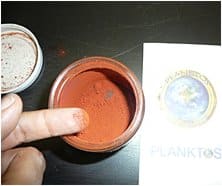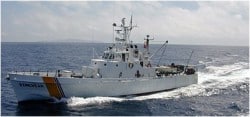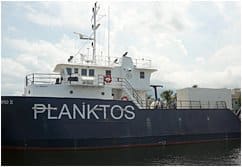by Sea Shepherd
The Planktos ship and its cargo of 100 tons of iron ore dust was scheduled to begin deployment of its controversial cargo the first week of August.
It was for this reason that Sea Shepherd Conservation Society decided to keep our ship the Farley Mowat in the Galapagos longer than planned. The crew of the Farley Mowat waited but kept themselves busy assisting the Galapagos Park rangers in their patrols and inspections of fishing operations.
The Planktos ship did not even leave Fort Lauderdale, Florida and has not yet loaded the iron ore dust for transportation. Planktos has not been able to secure EPA permits to legally take the iron ore dust to sea. In fact, it does not appear that Planktos has the organizational abilities to deploy the iron ore dust for some time, if at all.
Nonetheless, Sea Shepherd will continue to monitor the project. Sea Shepherd has a permanent patrol vessel in the Galapagos that can intercept any ship that Planktos eventually decides to send to waters near the Galapagos Marine Reserve.

“I am not judging them one way or another,” said Captain Paul Watson. “I do know that humans usually screw up when they seek to improve on nature but our opposition is purely a legal one. Planktos has to undertake an environmental assessment, they need to get a permit from the EPA and they need to get approval from the Ecuadorian Ministry of the Environment, from the Director of the Galapagos National Park and from the Darwin Research Centre in the Galapagos. If all these agencies become satisfied with the project then we will have no problem with it but our obligation is to protect the Galapagos National Park Marine Reserve. Right now the National Park views the Planktos project as a threat. Our duty is to intervene against threats to the Park.”
The Galapagos National Park and Sea Shepherd are concerned that the iron ore dust could drift into the waters of the Marine Reserve and there is no scientific evidence to determine if a plankton bloom in or around the marine reserve will be a good thing or a bad thing. Increased levels of plankton could mean depletion of oxygen from the sea that could be detrimental to other marine species.
Sea Shepherd Conservation Society is aware that Planktos is concerned about an intervention by a Sea Shepherd ship and crew. “They know we are not Greenpeace,” said Captain Watson. “They know we won’t be just showing up to hang banners and take snapshots. They know we take any threats to the security of the Galapagos very seriously.”

Sea Shepherd donated vessel Sirenian (now Yoshka)
on patrol in the Galapagos Marine Reserve



